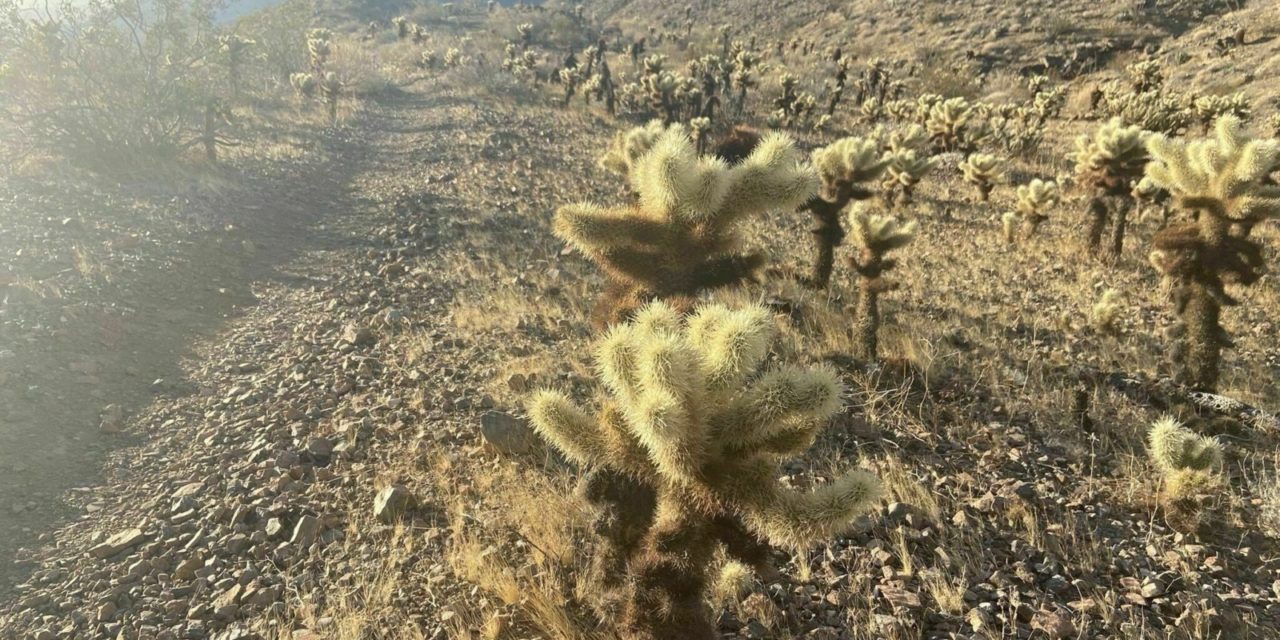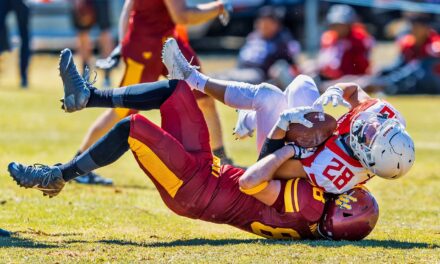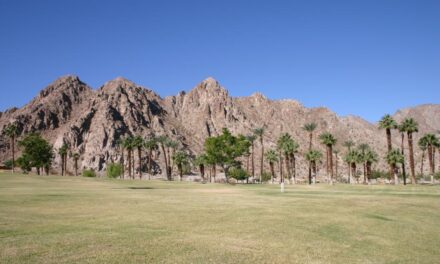Today, hikers and a few mountain biker enthusiasts primarily use the Boo Hoff in the La Quinta Cove.
Day hikers can enjoy great vistas and the ocotillo on a hike into the foothills from La Quinta Cove.
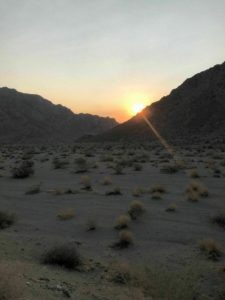
The sun rises over the trailhead for the Boo Hoff Trail.
The Boo Hoff Trail runs 5.8-miles round-trip with an elevation gain of 1290 feet. It’s best done October-April; in fact, the trail is closed July 1 to Sept. 30 so hikers don’t disturb bighorn sheep.
To reach the trailhead, from Calif. Hwy. 111 in La Quinta, take Washington Street south. Next, turn right/west onto Eisenhower Drive. At Avenida Bermudas, go right/southwest; be aware that the street name changes to Calle Tectate. Turn left/south into the parking lot for the trailhead, which is directly across the street from Avenida Ramirez.
From there, you’ll cross the sandy, gradually ascending wash that sits at the Cove Oasis and head into the Santa Rosa and San Jacinto Mountains National Monument.
At about 0.85 miles, the trail leave the wash and begins climbing a ridgeline that heads up Martinez Mountain’s base. The singletrack heads through desert terrain the entire way.
Patches of barrel cactus can be seen along the trail. Teddy bear cholla also pops up.
Without a doubt, though, the ocotillo steals the show, especially when it blooms. The ocotillo is fat here. If you hike the trail within a few days after rain, it bursts with green leaves. Bright crimson flowers also can appear, though they are more likely to do so in spring and summer than fall.
A mature ocotillo can reach a height of 33 feet. The plant consists of several branches that grow like poles from its base. Though the place looks like cactus, genetically it’s more closely related to the blueberry bush.
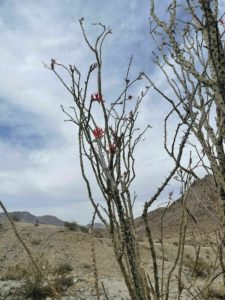
The ocotillo’s striking red flower usually blooms a few days after a rainfall.
Mid-February through April offers an opportunity to see a variety of desert wildflowers along the trail. Among them are the desert five-spot and the ghost flower.
The magenta desert five-star is easy to spot with its colorful petals against the tawny scrubland. Five pink to red circles on the petals form a dot-to-dot circle.
The white to manila ghost flower does not produce nectar so relies on mimicry to pollinate. It looks like the sand blazing star and so deceives the Xeralictus bee into checking it out.
A variety of birds and plenty of small lizards and mammals thrive on the slope. You’re also in bighorn sheep country, so keep an eye out for them. If spotting bighorn, stay on the trail to limit your effect on them.
One interesting insect you may spot along the trail is the master blister beetle. Ranging between a half-inch to 1.3-inches in length, you can’t miss its striking red head and black wings. Their larvae attack bee nests while the adult chews brittlebush leaves.
Though not poisonous, they can bite, so steer clear of them – though usually they will fly away if you do get close.
At roughly 1.9 miles, the trail begins switchbacking to its top.
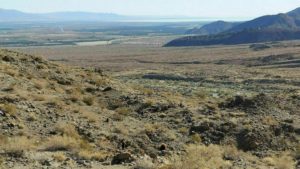
The top of the Boo Hoff Trail offers a great vista of the Salton Sea.
These switchbacks have existed for centuries. Originally a historic Indian path, an equestrian group during the 20th century improved it for use by horses. Today, hikers and a few mountain biker enthusiasts primarily use the Boo Hoff. The trail is named for the founder of the equestrian group, the Desert Riders.
You’ll reach the top at 2.9 miles. You’re at 1644 feet above sea level and will be treated to a great vista. The Salton Sea is to the northeast. The Martinez Landslide also is apparent. Just beyond it on the hillside is the waterline of ancient Lake Cahuilla. To the northwest is Mount San Jacinto, which looms over Palm Springs.
At the top, the Guadalupe Trail begins and heads up into a canyon to the southwest. Another trail loops east to La Quinta. The shortest way back to your vehicle, though, is to simply retrace your steps down the foothill.
As is typical of urban fringe trails in the Coachella Valley, there’s no shade, so be sure to don sunscreen, sunglasses and a sunhat. Dogs are not allowed on the trail.
Image Sources
- Teddy bear cholla: Rob Bignell

